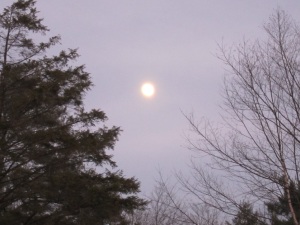 When I moved to the city, the idea was, as urban-planning professionals keep telling us, that the clustering of services and housing for the many on a condensed footprint is the rational way to live. I guess that I interpreted this concept as convenience. A dense neighborhood, close to amenities – how could that be bad? The city neighborhood we chose to inhabit, at that time, was down on its luck (otherwise, how could we have afforded it?), but it was convenient: to transportation, to supermarkets, to the downtown center (only six miles) and to the most natural portion of the municipal park system. It seemed to have it all. We could walk to two supermarkets, never mind that the closest of the two never had anything besides toilet paper that we were looking for and the other, a mile’s walk one way, had possibly three things that we wanted.
When I moved to the city, the idea was, as urban-planning professionals keep telling us, that the clustering of services and housing for the many on a condensed footprint is the rational way to live. I guess that I interpreted this concept as convenience. A dense neighborhood, close to amenities – how could that be bad? The city neighborhood we chose to inhabit, at that time, was down on its luck (otherwise, how could we have afforded it?), but it was convenient: to transportation, to supermarkets, to the downtown center (only six miles) and to the most natural portion of the municipal park system. It seemed to have it all. We could walk to two supermarkets, never mind that the closest of the two never had anything besides toilet paper that we were looking for and the other, a mile’s walk one way, had possibly three things that we wanted.
There were two shopping district streets about a half-mile or less walk, one up the hill from our street and the other down. The upper one was quaint, sort of behind the times, but it had services like hardware stores, banks, real-estate offices with notaries, a card shop, shoe stores, etc. The lower one was on the skids, with many boarded-up storefronts, too many bars, a plumbing supply and a roofing supply. But a new wave of people saw opportunity there, and some trendy restaurants opened and, eventually, they were followed by antiques, boutiques, galleries and designer-kitchen shops. It was new and exciting, at first, to see life where there had been cobwebs, but the downside was twofold. As the lower street gentrified, it killed off the upper street, which now looks as shantytown-ish as the latter had been before its makeover. And, because of the trendiness factor, people came from everywhere to see the lower street and, as a result, more and more restaurants and bars opened – more expensive versions of what had been. The clientele kept getting younger and younger, and drank more and more. Some of the restaurants gave way to bars, and the whole street became a college-student drinking mall. More students, more cars. A 19th-century mill town became an SUV parking lot, and all the barflies ended up drunk and disorderly on the streets at 2 am. Not terribly convenient.
One appeal of this neighborhood is that it had some greenspace left, unlike some of the other residential areas in the city. That was probably because of the neighborhood’s topography of steep hills, rendering some sites difficult to put a structure on. Not anymore. Now every scrap of open land, no matter the slope or narrowness or absurdity of building upon it, either has been or is being built on. In addition to the number of vehicles reducing two-lane streets to one, the number of houses are choking the life out of the blocks and making the same damn canyons that kept us from choosing other neighborhoods over this one. Very inconvenient.
When I go downtown into the city’s center, I notice very nice houses, cheek to jowl (well, they are rowhouses), now with 20-story high-rises built right next door, and where open space means having a parking lot with a hundred cars in it at any given time. Because of a lack of yards, often these houses will have decks on their second or third floors. Of course, the sky is open but everything else feels so confining, surrounded by building facades, backs of restaurants and their Dumpsters and exhaust fans, or the exquisite view of blacktop and cars that resembles the shipping port’s cargo holding lots. Yes, owners can walk to a number of amenities from such houses, but do they? Or do they feel as prisoners in their lofty towers? I feel a bit imprisoned in my house; not that I am afraid but, rather, it is uncomfortable to be outside among the whooping denizens.
I think that one has to give up many lifestyle conveniences to live conveniently. There are so many tradeoffs. What is convenient about having to have bars on your doors and windows? Or to live in a cloud of exhaust fumes day in, day out? Or to hear the incessant sounds of humans and machines without respite?
We have recently decided to live in a more rural town. We haven’t made the physical move yet, but the process of weighing and comparisons are inevitable. In a more sparsely populated area, the conveniences are fewer but so are the inconveniences of civilization. Being able to breathe – not only spatially, but to inhale the scent of pine, wood fires, rushing creeks and mountain air. These are conveniences, too. Watching bunnies play, having wild turkeys poke around in the meadow, listening to the sound of the stream and, at first, thinking that its whooshing sound is that of a highway but, no, it is water! These are not the usual conveniences we are taught to appreciate, but these are the ones we instantly, instinctually respond to; we just don’t think of them as conveniences, merely nature. And then there is the very real convenience of feeling like you can go outside on your own property and not be stepping on someone else’s turf, or even having to look at or hear someone else’s assertion of his or her presence. Yes, there are neighbors, but they are both near and far, not so close that you can’t escape them. And if you want to rub elbows with others, walk a few blocks into the town center, but leave it behind when you have quenched your thirst.
Convenience can have many meanings, I am beginning to see. Maybe it can also be a state of not having so much within your reach; enough but not over-the-top too much, and having the convenience of savoring the moment.

 We are leaving a place and we are happy to be doing so, and it’s about time.
We are leaving a place and we are happy to be doing so, and it’s about time.







